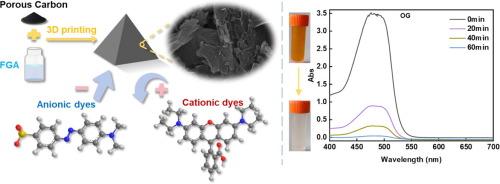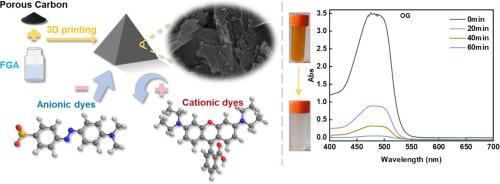阴离子染料在3D打印气凝胶和多孔碳复合吸附剂上的选择性吸附
IF 9
1区 工程技术
Q1 ENGINEERING, CHEMICAL
引用次数: 0
摘要
染料作为一种广泛存在的污染物,在使用后需要进行深度净化处理。传统的染料纯化方法不能满足染料选择性纯化的需要,特别是不能满足阴离子和阳离子染料分离的需要。在本研究中,我们采用三维(3D)打印技术制备了多孔碳(PC)和发泡明胶气凝胶(FGA)的复合吸附剂(FGA- pcs)。显微分析表明,复合吸附剂具有明确的晶格结构。代表性吸附剂的SBET值为1019 m2 g−1,孔隙体积为1.43 cm3 g−1。吸附60 min后,阴离子染料Orange-G (OG)和Methyl-Orange (MO)的纯化率分别达到99 %和92 %,代表性的吸附剂为FGA-PC。阳离子染料Azure-A (TA)和罗丹明- b (RB)的分离率分别为0.55 %和9.5 %,对阴离子染料具有良好的分离能力。随着3D打印的发展,PC和FGA的结合更加紧密。根据实验和密度泛函理论(DFT)的结果,可以证明FGA的电子部分转移到PC上,复合吸附剂的偶极矩可以改变。因此,FGA-PC复合吸附剂对阴离子染料具有良好的吸附选择性。本文章由计算机程序翻译,如有差异,请以英文原文为准。


The selective adsorption of anionic dyes over 3D printing composite sorbents of aerogel and porous carbon
As a pollutant widely presented, the dye needs deep purification treatments after use. The traditional ways for dye purification cannot meet the need of selective purification for dyes, especially for the separation between anionic and cationic dyes. In this study, we employ three-dimensional (3D) printing technology to prepare composite sorbents (FGA-PCs) with porous carbon (PC) and foaming gelatin aerogel (FGA). Microscopic analysis indicates that the composite sorbents have well-defined lattice structures. The SBET value of the representative sorbent is 1019 m2 g−1, and the pore-volume is 1.43 cm3 g−1. After adsorption treatment for 60 min, the purification rate of anionic dyes Orange-G (OG) and Methyl-Orange (MO) reach 99 % and 92 %, respectively, with a representative sorbent FGA-PC. In contract, those of cationic dyes Azure-A (TA) and Rhodamine-B (RB) are only 0.55 % and 9.5 %, respectively, showing excellent separation capability for anionic dyes. With the 3D printing, the PC and FGA are combined strongly. According to the experimental and the density functional theory (DFT) results, it can be proved that the electrons of the FGA partially transfer to the PC and the dipole moment of composite sorbents can be changed. Therefore, the composite sorbent FGA-PC displays good adsorption selectivity for anionic dyes.
求助全文
通过发布文献求助,成功后即可免费获取论文全文。
去求助
来源期刊

Separation and Purification Technology
工程技术-工程:化工
CiteScore
14.00
自引率
12.80%
发文量
2347
审稿时长
43 days
期刊介绍:
Separation and Purification Technology is a premier journal committed to sharing innovative methods for separation and purification in chemical and environmental engineering, encompassing both homogeneous solutions and heterogeneous mixtures. Our scope includes the separation and/or purification of liquids, vapors, and gases, as well as carbon capture and separation techniques. However, it's important to note that methods solely intended for analytical purposes are not within the scope of the journal. Additionally, disciplines such as soil science, polymer science, and metallurgy fall outside the purview of Separation and Purification Technology. Join us in advancing the field of separation and purification methods for sustainable solutions in chemical and environmental engineering.
 求助内容:
求助内容: 应助结果提醒方式:
应助结果提醒方式:


